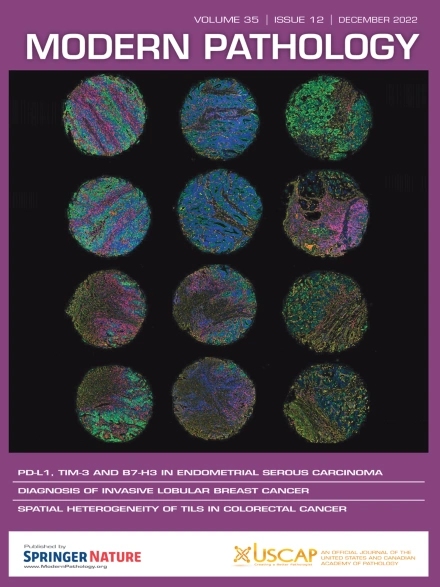Spatial Architecture of Single-Cell and Vasculature in Tumor Microenvironment Predicts Clinical Outcomes in Triple-Negative Breast Cancer
IF 7.1
1区 医学
Q1 PATHOLOGY
引用次数: 0
Abstract
Triple-negative breast cancer (TNBC) is an aggressive subtype of breast cancer with limited treatment options, which warrants the identification of novel therapeutic targets. Deciphering nuances in the tumor microenvironment (TME) may unveil insightful links between antitumor immunity and clinical outcomes; however, such connections remain underexplored. Here, we employed a data set derived from imaging mass cytometry of 71 TNBC patient specimens at single-cell resolution and performed in-depth quantifications with a suite of multiscale computational algorithms. The TNBC TME reflected a heterogeneous ecosystem with high spatial and compositional heterogeneity. Spatial analysis identified 10 recurrent cellular neighborhoods—a collection of local TME characteristics with unique cell components. The prevalence of cellular neighborhoods enriched with B cells, fibroblasts, and tumor cells, in conjunction with vascular density and perivasculature immune profiles, could significantly enrich long-term survivors. Furthermore, relative spatial colocalization of SMAhi fibroblasts and tumor cells compared with B cells correlated significantly with favorable clinical outcomes. Using a deep learning model trained on engineered spatial data, we can predict with high accuracy (mean area under the receiver operating characteristic curve of 5-fold cross-validation = 0.71) how a separate cohort of patients in the NeoTRIP clinical trial will respond to treatment based on baseline TME features. These data reinforce that the TME architecture is structured in cellular compositions, spatial organizations, vasculature biology, and molecular profiles and suggest novel imaging-based biomarkers for the treatment development in the context of TNBC.
肿瘤微环境中单细胞和血管的空间结构可预测三阴性乳腺癌的临床结果
三阴性乳腺癌(TNBC)是乳腺癌的一种侵袭性亚型,治疗方案有限,因此需要确定新的治疗靶点。破译肿瘤微环境(TME)中的细微差别可能会揭示抗肿瘤免疫与临床结果之间的深刻联系,但这种联系仍未得到充分探索。在这里,我们采用了一个数据集,该数据集来自 71 例 TNBC 患者标本的单细胞分辨率成像质谱,并利用一套多尺度计算算法进行了深入量化。TNBC TME 反映了一个具有高度空间异质性和成分异质性的异质性生态系统。空间分析确定了十个重复出现的细胞邻域(CN)--具有独特细胞成分的局部TME特征集合。富含B细胞、成纤维细胞和肿瘤细胞的细胞邻域与血管密度和血管周围免疫特征相结合,可显著丰富长期存活者的细胞邻域。此外,与B细胞相比,SMAhi成纤维细胞和肿瘤细胞的相对空间共定位与良好的临床结果有显著相关性。利用在工程空间数据上训练的深度学习模型,我们可以根据基线 TME 特征,高精度地预测 NeoTRIP 临床试验中的一组患者对治疗的反应(5 倍交叉验证的平均 AUC = 0.71)。这些数据强化了TME结构在细胞组成、空间组织、血管生物学和分子特征方面的结构性,并为TNBC的治疗开发提出了基于成像的新型生物标记物。
本文章由计算机程序翻译,如有差异,请以英文原文为准。
求助全文
约1分钟内获得全文
求助全文
来源期刊

Modern Pathology
医学-病理学
CiteScore
14.30
自引率
2.70%
发文量
174
审稿时长
18 days
期刊介绍:
Modern Pathology, an international journal under the ownership of The United States & Canadian Academy of Pathology (USCAP), serves as an authoritative platform for publishing top-tier clinical and translational research studies in pathology.
Original manuscripts are the primary focus of Modern Pathology, complemented by impactful editorials, reviews, and practice guidelines covering all facets of precision diagnostics in human pathology. The journal's scope includes advancements in molecular diagnostics and genomic classifications of diseases, breakthroughs in immune-oncology, computational science, applied bioinformatics, and digital pathology.
 求助内容:
求助内容: 应助结果提醒方式:
应助结果提醒方式:


